Entrepreneurship Theory and Practice
VerifiedAdded on 2020/01/07
|17
|4541
|1056
Literature Review
AI Summary
This assignment delves into the multifaceted world of entrepreneurship. It examines established theories and practices that underpin the entrepreneurial process, including how opportunities are recognized, decisions are made, and the overall influence of entrepreneurship on economic development. The provided readings offer diverse perspectives on entrepreneurship, highlighting its complexities and significance in contemporary society.
Contribute Materials
Your contribution can guide someone’s learning journey. Share your
documents today.

ENTREPRENEURSHIP AND SMALL BUSINESS MANAGEMENT
University
UNDERSTANDING ENTREPRENEURSHIP
Name
ID
Unit Title
Code number
Lecturer’s name
Page 1 of 17
University
UNDERSTANDING ENTREPRENEURSHIP
Name
ID
Unit Title
Code number
Lecturer’s name
Page 1 of 17
Secure Best Marks with AI Grader
Need help grading? Try our AI Grader for instant feedback on your assignments.
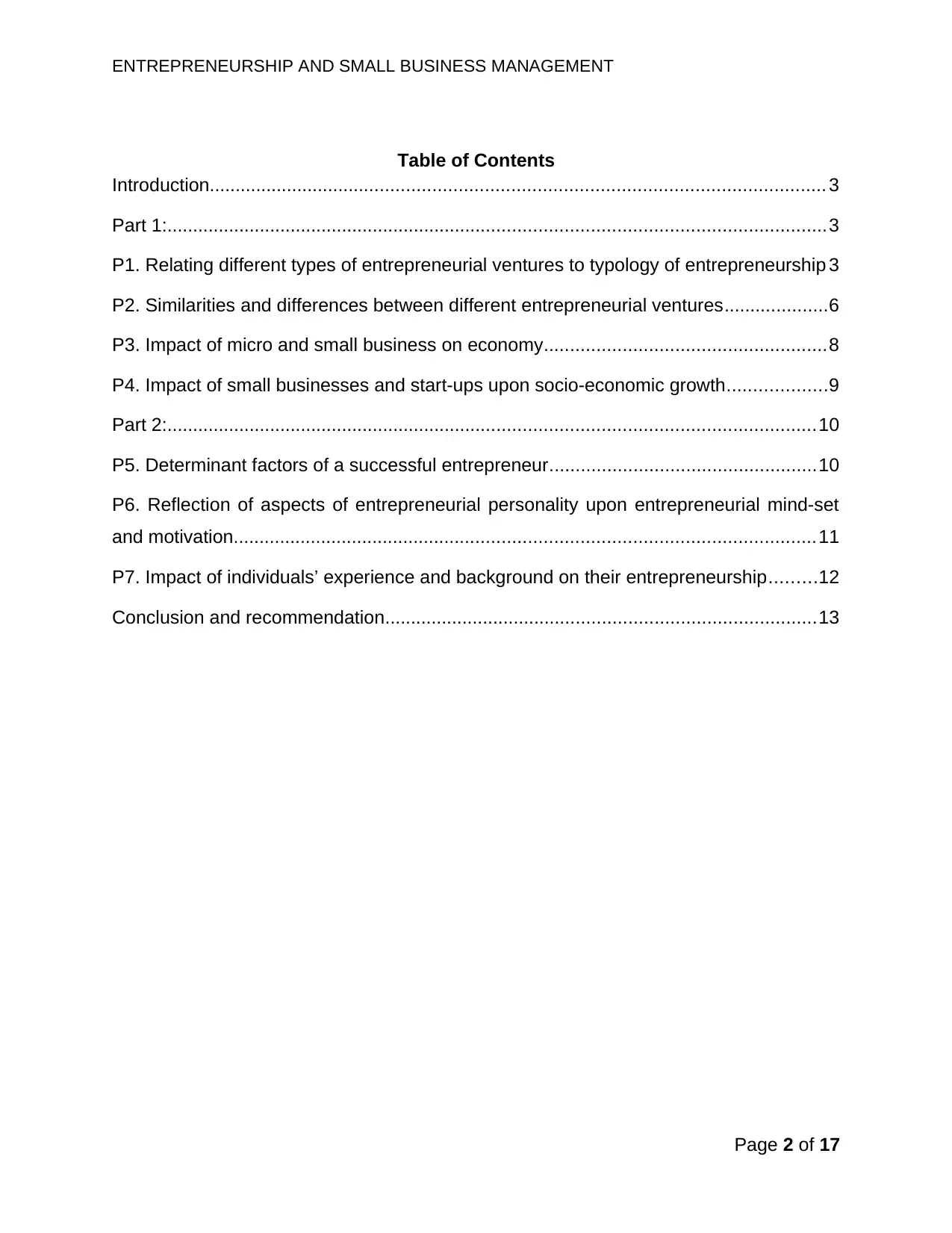
ENTREPRENEURSHIP AND SMALL BUSINESS MANAGEMENT
Table of Contents
Introduction...................................................................................................................... 3
Part 1:...............................................................................................................................3
P1. Relating different types of entrepreneurial ventures to typology of entrepreneurship 3
P2. Similarities and differences between different entrepreneurial ventures....................6
P3. Impact of micro and small business on economy......................................................8
P4. Impact of small businesses and start-ups upon socio-economic growth...................9
Part 2:.............................................................................................................................10
P5. Determinant factors of a successful entrepreneur...................................................10
P6. Reflection of aspects of entrepreneurial personality upon entrepreneurial mind-set
and motivation................................................................................................................11
P7. Impact of individuals’ experience and background on their entrepreneurship.........12
Conclusion and recommendation...................................................................................13
Page 2 of 17
Table of Contents
Introduction...................................................................................................................... 3
Part 1:...............................................................................................................................3
P1. Relating different types of entrepreneurial ventures to typology of entrepreneurship 3
P2. Similarities and differences between different entrepreneurial ventures....................6
P3. Impact of micro and small business on economy......................................................8
P4. Impact of small businesses and start-ups upon socio-economic growth...................9
Part 2:.............................................................................................................................10
P5. Determinant factors of a successful entrepreneur...................................................10
P6. Reflection of aspects of entrepreneurial personality upon entrepreneurial mind-set
and motivation................................................................................................................11
P7. Impact of individuals’ experience and background on their entrepreneurship.........12
Conclusion and recommendation...................................................................................13
Page 2 of 17
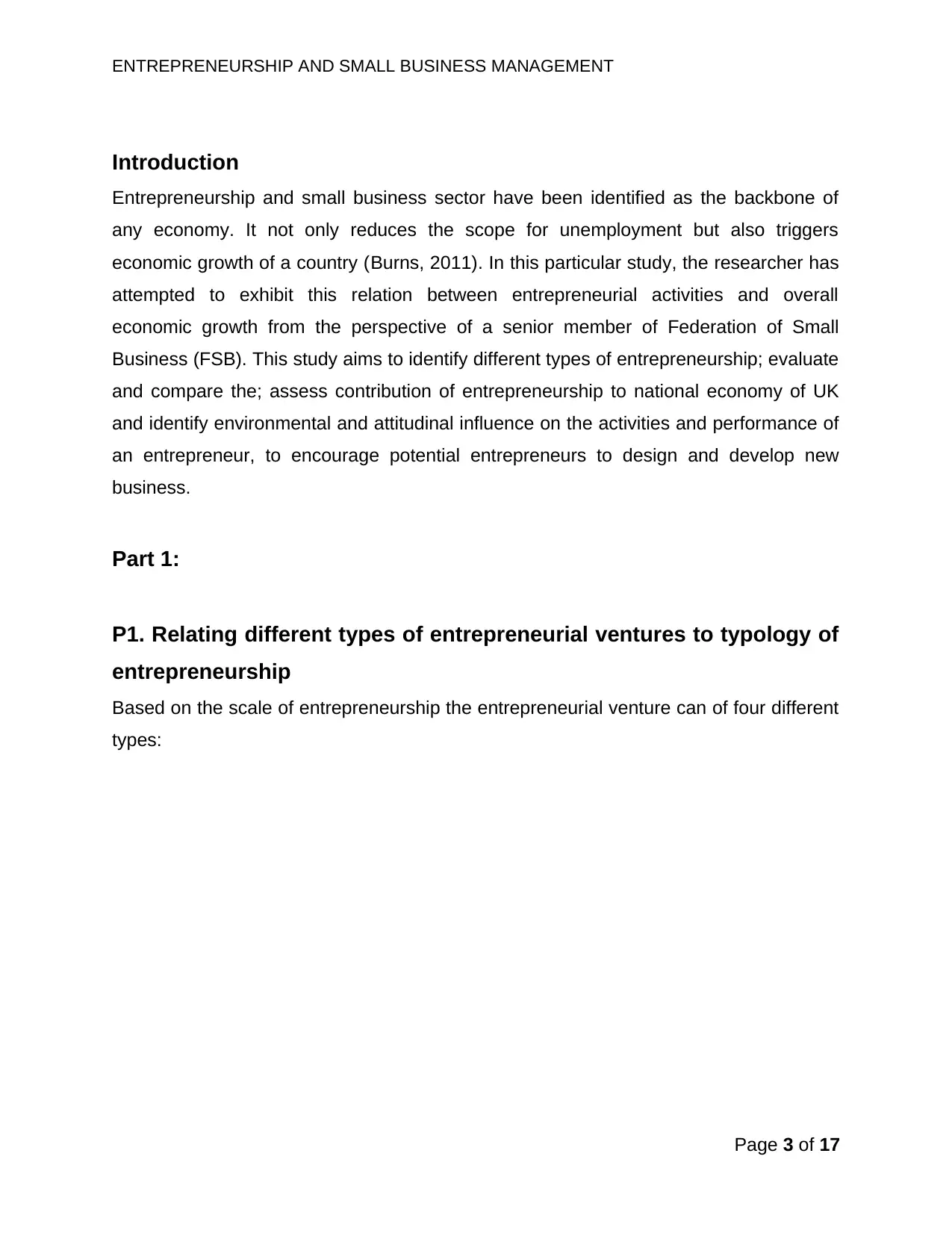
ENTREPRENEURSHIP AND SMALL BUSINESS MANAGEMENT
Introduction
Entrepreneurship and small business sector have been identified as the backbone of
any economy. It not only reduces the scope for unemployment but also triggers
economic growth of a country (Burns, 2011). In this particular study, the researcher has
attempted to exhibit this relation between entrepreneurial activities and overall
economic growth from the perspective of a senior member of Federation of Small
Business (FSB). This study aims to identify different types of entrepreneurship; evaluate
and compare the; assess contribution of entrepreneurship to national economy of UK
and identify environmental and attitudinal influence on the activities and performance of
an entrepreneur, to encourage potential entrepreneurs to design and develop new
business.
Part 1:
P1. Relating different types of entrepreneurial ventures to typology of
entrepreneurship
Based on the scale of entrepreneurship the entrepreneurial venture can of four different
types:
Page 3 of 17
Introduction
Entrepreneurship and small business sector have been identified as the backbone of
any economy. It not only reduces the scope for unemployment but also triggers
economic growth of a country (Burns, 2011). In this particular study, the researcher has
attempted to exhibit this relation between entrepreneurial activities and overall
economic growth from the perspective of a senior member of Federation of Small
Business (FSB). This study aims to identify different types of entrepreneurship; evaluate
and compare the; assess contribution of entrepreneurship to national economy of UK
and identify environmental and attitudinal influence on the activities and performance of
an entrepreneur, to encourage potential entrepreneurs to design and develop new
business.
Part 1:
P1. Relating different types of entrepreneurial ventures to typology of
entrepreneurship
Based on the scale of entrepreneurship the entrepreneurial venture can of four different
types:
Page 3 of 17
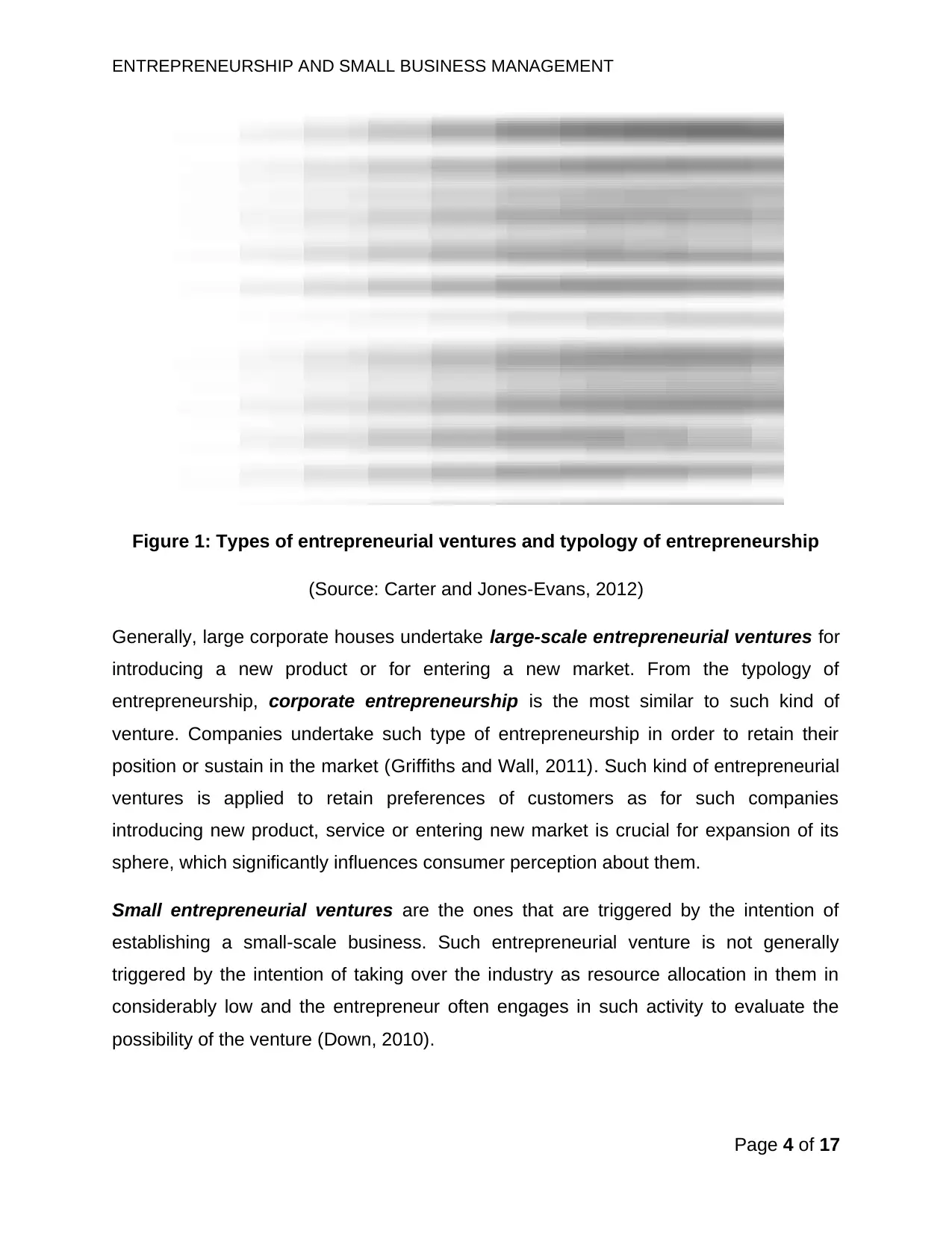
ENTREPRENEURSHIP AND SMALL BUSINESS MANAGEMENT
Figure 1: Types of entrepreneurial ventures and typology of entrepreneurship
(Source: Carter and Jones-Evans, 2012)
Generally, large corporate houses undertake large-scale entrepreneurial ventures for
introducing a new product or for entering a new market. From the typology of
entrepreneurship, corporate entrepreneurship is the most similar to such kind of
venture. Companies undertake such type of entrepreneurship in order to retain their
position or sustain in the market (Griffiths and Wall, 2011). Such kind of entrepreneurial
ventures is applied to retain preferences of customers as for such companies
introducing new product, service or entering new market is crucial for expansion of its
sphere, which significantly influences consumer perception about them.
Small entrepreneurial ventures are the ones that are triggered by the intention of
establishing a small-scale business. Such entrepreneurial venture is not generally
triggered by the intention of taking over the industry as resource allocation in them in
considerably low and the entrepreneur often engages in such activity to evaluate the
possibility of the venture (Down, 2010).
Page 4 of 17
CorporateentrepreneurshipPublicSectorentrepreneurshipSocialentrepreneurshipIndependentorprivateentrepreneurshipAcademicentrepreneurshipLarge-scaleentrepreneurialventuresSmallentrepreneurialventuresMedium-scaleentrepreneurialventuresMicroentrepreneurialventures
Figure 1: Types of entrepreneurial ventures and typology of entrepreneurship
(Source: Carter and Jones-Evans, 2012)
Generally, large corporate houses undertake large-scale entrepreneurial ventures for
introducing a new product or for entering a new market. From the typology of
entrepreneurship, corporate entrepreneurship is the most similar to such kind of
venture. Companies undertake such type of entrepreneurship in order to retain their
position or sustain in the market (Griffiths and Wall, 2011). Such kind of entrepreneurial
ventures is applied to retain preferences of customers as for such companies
introducing new product, service or entering new market is crucial for expansion of its
sphere, which significantly influences consumer perception about them.
Small entrepreneurial ventures are the ones that are triggered by the intention of
establishing a small-scale business. Such entrepreneurial venture is not generally
triggered by the intention of taking over the industry as resource allocation in them in
considerably low and the entrepreneur often engages in such activity to evaluate the
possibility of the venture (Down, 2010).
Page 4 of 17
CorporateentrepreneurshipPublicSectorentrepreneurshipSocialentrepreneurshipIndependentorprivateentrepreneurshipAcademicentrepreneurshipLarge-scaleentrepreneurialventuresSmallentrepreneurialventuresMedium-scaleentrepreneurialventuresMicroentrepreneurialventures
Secure Best Marks with AI Grader
Need help grading? Try our AI Grader for instant feedback on your assignments.
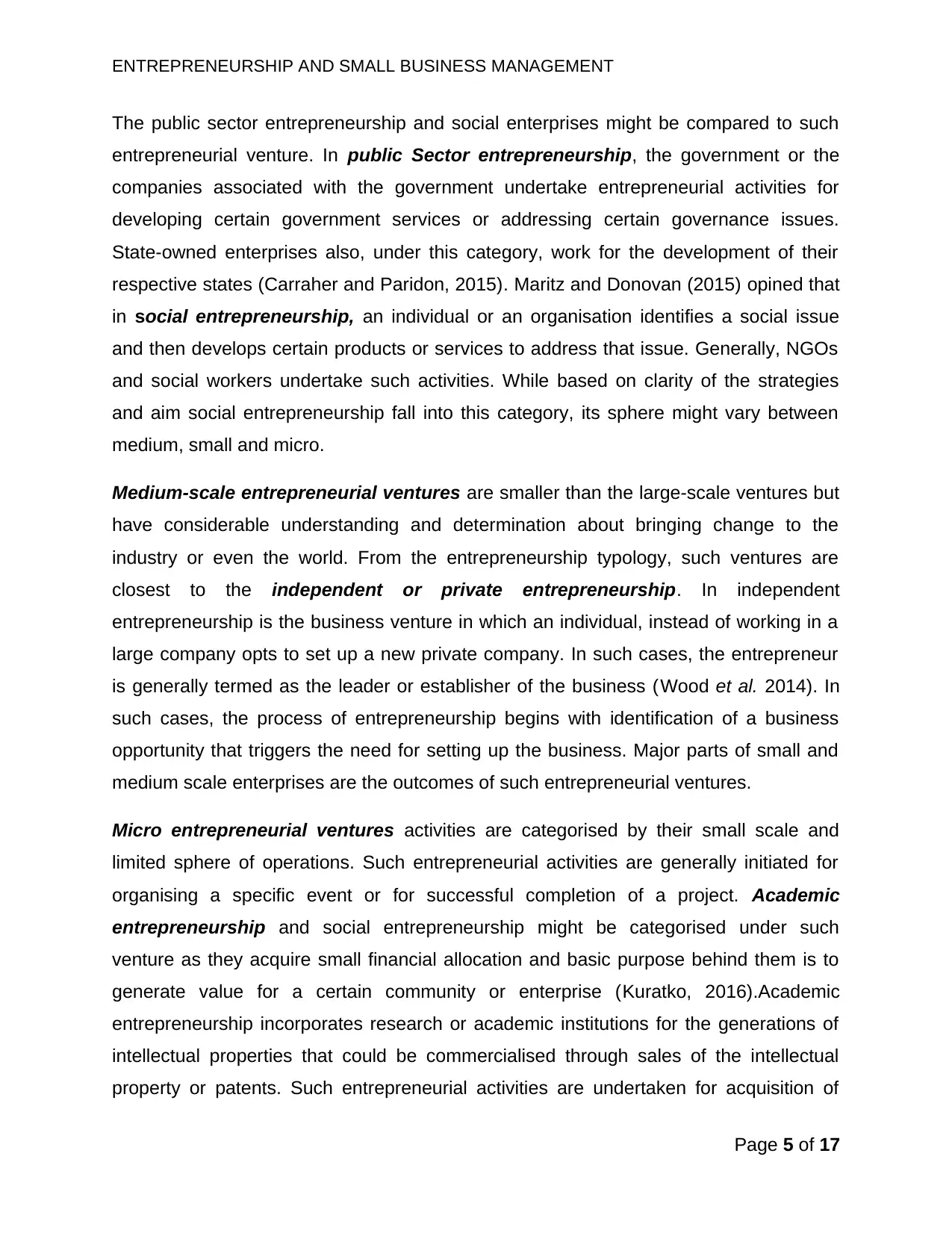
ENTREPRENEURSHIP AND SMALL BUSINESS MANAGEMENT
The public sector entrepreneurship and social enterprises might be compared to such
entrepreneurial venture. In public Sector entrepreneurship, the government or the
companies associated with the government undertake entrepreneurial activities for
developing certain government services or addressing certain governance issues.
State-owned enterprises also, under this category, work for the development of their
respective states (Carraher and Paridon, 2015). Maritz and Donovan (2015) opined that
in social entrepreneurship, an individual or an organisation identifies a social issue
and then develops certain products or services to address that issue. Generally, NGOs
and social workers undertake such activities. While based on clarity of the strategies
and aim social entrepreneurship fall into this category, its sphere might vary between
medium, small and micro.
Medium-scale entrepreneurial ventures are smaller than the large-scale ventures but
have considerable understanding and determination about bringing change to the
industry or even the world. From the entrepreneurship typology, such ventures are
closest to the independent or private entrepreneurship. In independent
entrepreneurship is the business venture in which an individual, instead of working in a
large company opts to set up a new private company. In such cases, the entrepreneur
is generally termed as the leader or establisher of the business (Wood et al. 2014). In
such cases, the process of entrepreneurship begins with identification of a business
opportunity that triggers the need for setting up the business. Major parts of small and
medium scale enterprises are the outcomes of such entrepreneurial ventures.
Micro entrepreneurial ventures activities are categorised by their small scale and
limited sphere of operations. Such entrepreneurial activities are generally initiated for
organising a specific event or for successful completion of a project. Academic
entrepreneurship and social entrepreneurship might be categorised under such
venture as they acquire small financial allocation and basic purpose behind them is to
generate value for a certain community or enterprise (Kuratko, 2016).Academic
entrepreneurship incorporates research or academic institutions for the generations of
intellectual properties that could be commercialised through sales of the intellectual
property or patents. Such entrepreneurial activities are undertaken for acquisition of
Page 5 of 17
The public sector entrepreneurship and social enterprises might be compared to such
entrepreneurial venture. In public Sector entrepreneurship, the government or the
companies associated with the government undertake entrepreneurial activities for
developing certain government services or addressing certain governance issues.
State-owned enterprises also, under this category, work for the development of their
respective states (Carraher and Paridon, 2015). Maritz and Donovan (2015) opined that
in social entrepreneurship, an individual or an organisation identifies a social issue
and then develops certain products or services to address that issue. Generally, NGOs
and social workers undertake such activities. While based on clarity of the strategies
and aim social entrepreneurship fall into this category, its sphere might vary between
medium, small and micro.
Medium-scale entrepreneurial ventures are smaller than the large-scale ventures but
have considerable understanding and determination about bringing change to the
industry or even the world. From the entrepreneurship typology, such ventures are
closest to the independent or private entrepreneurship. In independent
entrepreneurship is the business venture in which an individual, instead of working in a
large company opts to set up a new private company. In such cases, the entrepreneur
is generally termed as the leader or establisher of the business (Wood et al. 2014). In
such cases, the process of entrepreneurship begins with identification of a business
opportunity that triggers the need for setting up the business. Major parts of small and
medium scale enterprises are the outcomes of such entrepreneurial ventures.
Micro entrepreneurial ventures activities are categorised by their small scale and
limited sphere of operations. Such entrepreneurial activities are generally initiated for
organising a specific event or for successful completion of a project. Academic
entrepreneurship and social entrepreneurship might be categorised under such
venture as they acquire small financial allocation and basic purpose behind them is to
generate value for a certain community or enterprise (Kuratko, 2016).Academic
entrepreneurship incorporates research or academic institutions for the generations of
intellectual properties that could be commercialised through sales of the intellectual
property or patents. Such entrepreneurial activities are undertaken for acquisition of
Page 5 of 17
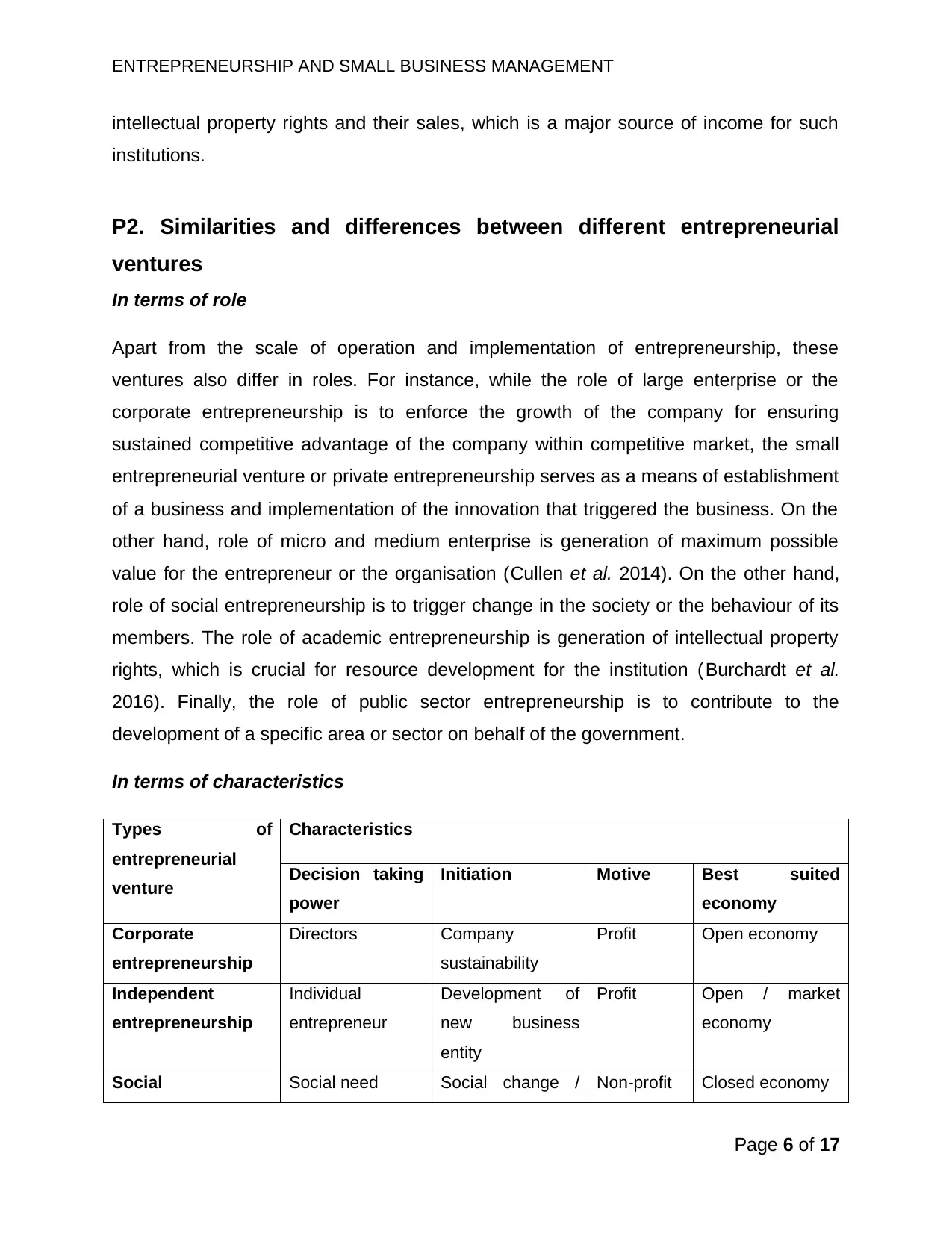
ENTREPRENEURSHIP AND SMALL BUSINESS MANAGEMENT
intellectual property rights and their sales, which is a major source of income for such
institutions.
P2. Similarities and differences between different entrepreneurial
ventures
In terms of role
Apart from the scale of operation and implementation of entrepreneurship, these
ventures also differ in roles. For instance, while the role of large enterprise or the
corporate entrepreneurship is to enforce the growth of the company for ensuring
sustained competitive advantage of the company within competitive market, the small
entrepreneurial venture or private entrepreneurship serves as a means of establishment
of a business and implementation of the innovation that triggered the business. On the
other hand, role of micro and medium enterprise is generation of maximum possible
value for the entrepreneur or the organisation (Cullen et al. 2014). On the other hand,
role of social entrepreneurship is to trigger change in the society or the behaviour of its
members. The role of academic entrepreneurship is generation of intellectual property
rights, which is crucial for resource development for the institution (Burchardt et al.
2016). Finally, the role of public sector entrepreneurship is to contribute to the
development of a specific area or sector on behalf of the government.
In terms of characteristics
Types of
entrepreneurial
venture
Characteristics
Decision taking
power
Initiation Motive Best suited
economy
Corporate
entrepreneurship
Directors Company
sustainability
Profit Open economy
Independent
entrepreneurship
Individual
entrepreneur
Development of
new business
entity
Profit Open / market
economy
Social Social need Social change / Non-profit Closed economy
Page 6 of 17
intellectual property rights and their sales, which is a major source of income for such
institutions.
P2. Similarities and differences between different entrepreneurial
ventures
In terms of role
Apart from the scale of operation and implementation of entrepreneurship, these
ventures also differ in roles. For instance, while the role of large enterprise or the
corporate entrepreneurship is to enforce the growth of the company for ensuring
sustained competitive advantage of the company within competitive market, the small
entrepreneurial venture or private entrepreneurship serves as a means of establishment
of a business and implementation of the innovation that triggered the business. On the
other hand, role of micro and medium enterprise is generation of maximum possible
value for the entrepreneur or the organisation (Cullen et al. 2014). On the other hand,
role of social entrepreneurship is to trigger change in the society or the behaviour of its
members. The role of academic entrepreneurship is generation of intellectual property
rights, which is crucial for resource development for the institution (Burchardt et al.
2016). Finally, the role of public sector entrepreneurship is to contribute to the
development of a specific area or sector on behalf of the government.
In terms of characteristics
Types of
entrepreneurial
venture
Characteristics
Decision taking
power
Initiation Motive Best suited
economy
Corporate
entrepreneurship
Directors Company
sustainability
Profit Open economy
Independent
entrepreneurship
Individual
entrepreneur
Development of
new business
entity
Profit Open / market
economy
Social Social need Social change / Non-profit Closed economy
Page 6 of 17
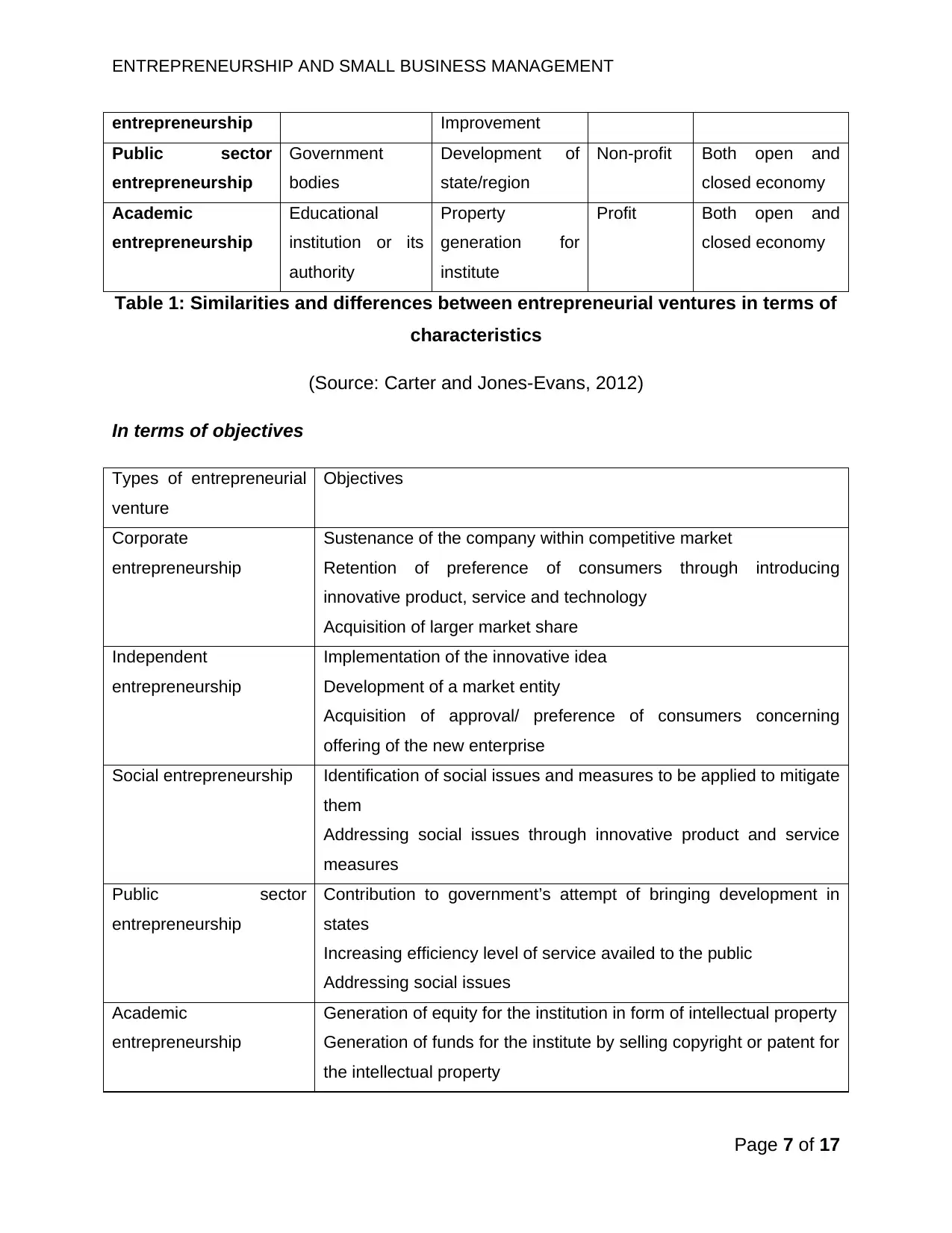
ENTREPRENEURSHIP AND SMALL BUSINESS MANAGEMENT
entrepreneurship Improvement
Public sector
entrepreneurship
Government
bodies
Development of
state/region
Non-profit Both open and
closed economy
Academic
entrepreneurship
Educational
institution or its
authority
Property
generation for
institute
Profit Both open and
closed economy
Table 1: Similarities and differences between entrepreneurial ventures in terms of
characteristics
(Source: Carter and Jones-Evans, 2012)
In terms of objectives
Types of entrepreneurial
venture
Objectives
Corporate
entrepreneurship
Sustenance of the company within competitive market
Retention of preference of consumers through introducing
innovative product, service and technology
Acquisition of larger market share
Independent
entrepreneurship
Implementation of the innovative idea
Development of a market entity
Acquisition of approval/ preference of consumers concerning
offering of the new enterprise
Social entrepreneurship Identification of social issues and measures to be applied to mitigate
them
Addressing social issues through innovative product and service
measures
Public sector
entrepreneurship
Contribution to government’s attempt of bringing development in
states
Increasing efficiency level of service availed to the public
Addressing social issues
Academic
entrepreneurship
Generation of equity for the institution in form of intellectual property
Generation of funds for the institute by selling copyright or patent for
the intellectual property
Page 7 of 17
entrepreneurship Improvement
Public sector
entrepreneurship
Government
bodies
Development of
state/region
Non-profit Both open and
closed economy
Academic
entrepreneurship
Educational
institution or its
authority
Property
generation for
institute
Profit Both open and
closed economy
Table 1: Similarities and differences between entrepreneurial ventures in terms of
characteristics
(Source: Carter and Jones-Evans, 2012)
In terms of objectives
Types of entrepreneurial
venture
Objectives
Corporate
entrepreneurship
Sustenance of the company within competitive market
Retention of preference of consumers through introducing
innovative product, service and technology
Acquisition of larger market share
Independent
entrepreneurship
Implementation of the innovative idea
Development of a market entity
Acquisition of approval/ preference of consumers concerning
offering of the new enterprise
Social entrepreneurship Identification of social issues and measures to be applied to mitigate
them
Addressing social issues through innovative product and service
measures
Public sector
entrepreneurship
Contribution to government’s attempt of bringing development in
states
Increasing efficiency level of service availed to the public
Addressing social issues
Academic
entrepreneurship
Generation of equity for the institution in form of intellectual property
Generation of funds for the institute by selling copyright or patent for
the intellectual property
Page 7 of 17
Paraphrase This Document
Need a fresh take? Get an instant paraphrase of this document with our AI Paraphraser
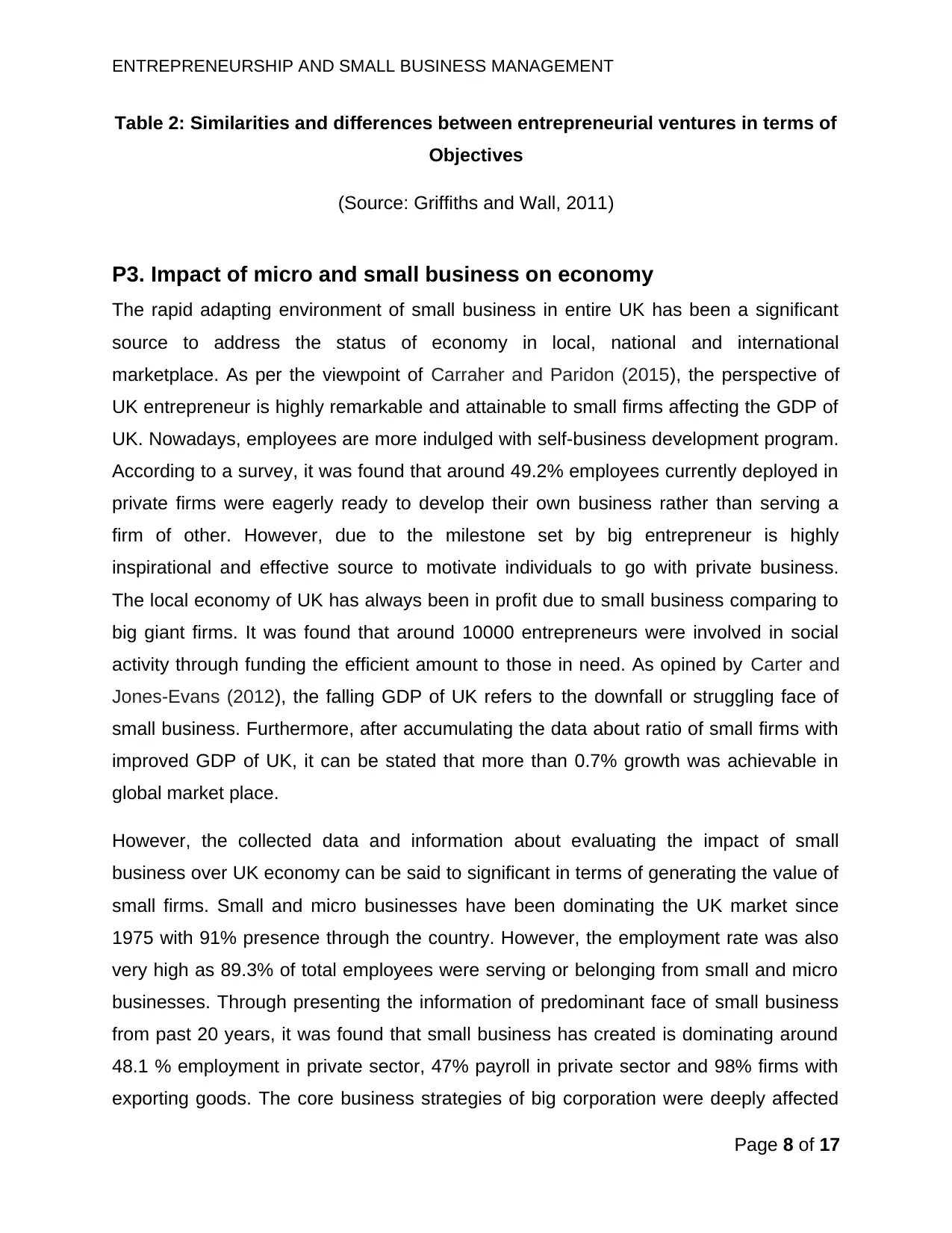
ENTREPRENEURSHIP AND SMALL BUSINESS MANAGEMENT
Table 2: Similarities and differences between entrepreneurial ventures in terms of
Objectives
(Source: Griffiths and Wall, 2011)
P3. Impact of micro and small business on economy
The rapid adapting environment of small business in entire UK has been a significant
source to address the status of economy in local, national and international
marketplace. As per the viewpoint of Carraher and Paridon (2015), the perspective of
UK entrepreneur is highly remarkable and attainable to small firms affecting the GDP of
UK. Nowadays, employees are more indulged with self-business development program.
According to a survey, it was found that around 49.2% employees currently deployed in
private firms were eagerly ready to develop their own business rather than serving a
firm of other. However, due to the milestone set by big entrepreneur is highly
inspirational and effective source to motivate individuals to go with private business.
The local economy of UK has always been in profit due to small business comparing to
big giant firms. It was found that around 10000 entrepreneurs were involved in social
activity through funding the efficient amount to those in need. As opined by Carter and
Jones-Evans (2012), the falling GDP of UK refers to the downfall or struggling face of
small business. Furthermore, after accumulating the data about ratio of small firms with
improved GDP of UK, it can be stated that more than 0.7% growth was achievable in
global market place.
However, the collected data and information about evaluating the impact of small
business over UK economy can be said to significant in terms of generating the value of
small firms. Small and micro businesses have been dominating the UK market since
1975 with 91% presence through the country. However, the employment rate was also
very high as 89.3% of total employees were serving or belonging from small and micro
businesses. Through presenting the information of predominant face of small business
from past 20 years, it was found that small business has created is dominating around
48.1 % employment in private sector, 47% payroll in private sector and 98% firms with
exporting goods. The core business strategies of big corporation were deeply affected
Page 8 of 17
Table 2: Similarities and differences between entrepreneurial ventures in terms of
Objectives
(Source: Griffiths and Wall, 2011)
P3. Impact of micro and small business on economy
The rapid adapting environment of small business in entire UK has been a significant
source to address the status of economy in local, national and international
marketplace. As per the viewpoint of Carraher and Paridon (2015), the perspective of
UK entrepreneur is highly remarkable and attainable to small firms affecting the GDP of
UK. Nowadays, employees are more indulged with self-business development program.
According to a survey, it was found that around 49.2% employees currently deployed in
private firms were eagerly ready to develop their own business rather than serving a
firm of other. However, due to the milestone set by big entrepreneur is highly
inspirational and effective source to motivate individuals to go with private business.
The local economy of UK has always been in profit due to small business comparing to
big giant firms. It was found that around 10000 entrepreneurs were involved in social
activity through funding the efficient amount to those in need. As opined by Carter and
Jones-Evans (2012), the falling GDP of UK refers to the downfall or struggling face of
small business. Furthermore, after accumulating the data about ratio of small firms with
improved GDP of UK, it can be stated that more than 0.7% growth was achievable in
global market place.
However, the collected data and information about evaluating the impact of small
business over UK economy can be said to significant in terms of generating the value of
small firms. Small and micro businesses have been dominating the UK market since
1975 with 91% presence through the country. However, the employment rate was also
very high as 89.3% of total employees were serving or belonging from small and micro
businesses. Through presenting the information of predominant face of small business
from past 20 years, it was found that small business has created is dominating around
48.1 % employment in private sector, 47% payroll in private sector and 98% firms with
exporting goods. The core business strategies of big corporation were deeply affected
Page 8 of 17
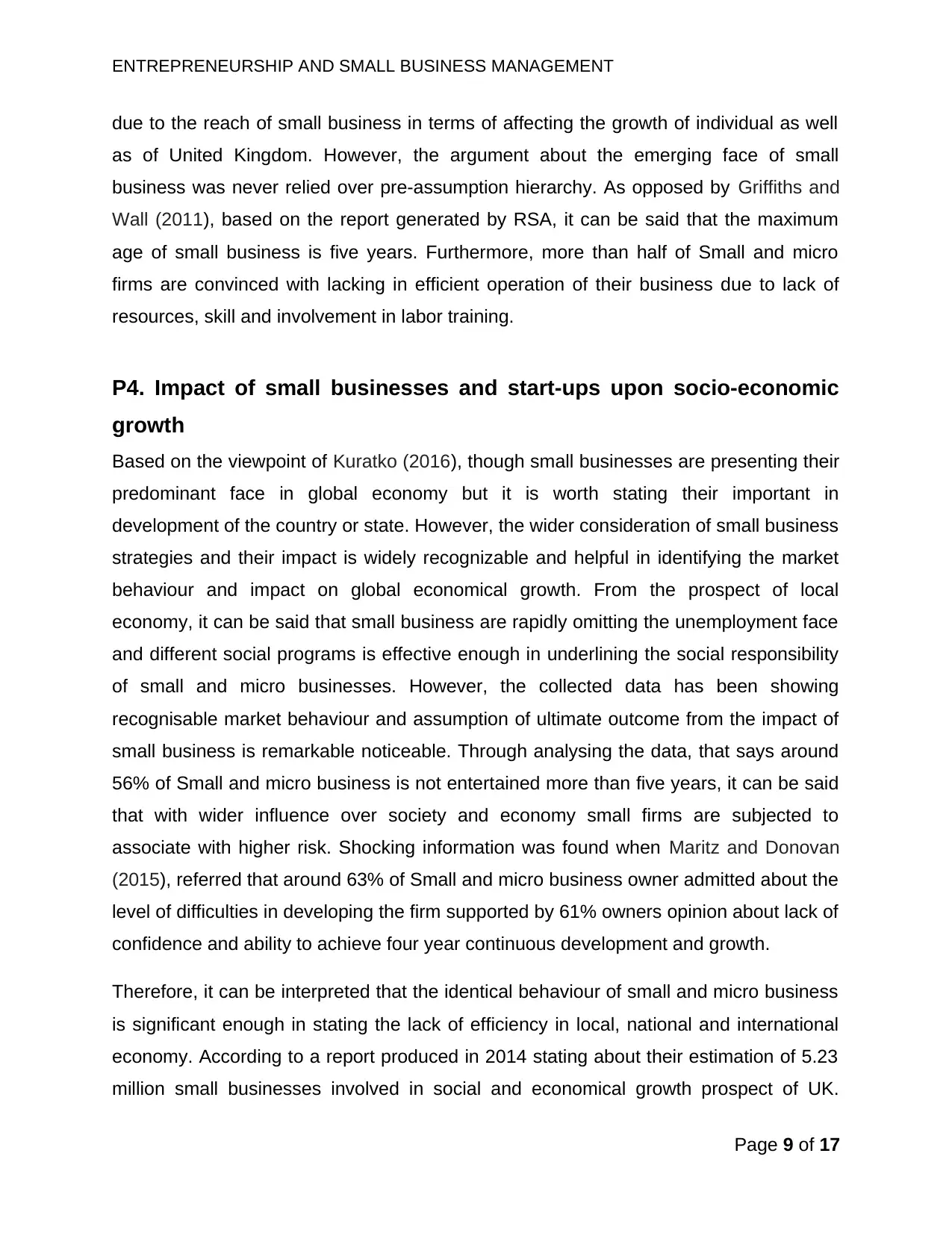
ENTREPRENEURSHIP AND SMALL BUSINESS MANAGEMENT
due to the reach of small business in terms of affecting the growth of individual as well
as of United Kingdom. However, the argument about the emerging face of small
business was never relied over pre-assumption hierarchy. As opposed by Griffiths and
Wall (2011), based on the report generated by RSA, it can be said that the maximum
age of small business is five years. Furthermore, more than half of Small and micro
firms are convinced with lacking in efficient operation of their business due to lack of
resources, skill and involvement in labor training.
P4. Impact of small businesses and start-ups upon socio-economic
growth
Based on the viewpoint of Kuratko (2016), though small businesses are presenting their
predominant face in global economy but it is worth stating their important in
development of the country or state. However, the wider consideration of small business
strategies and their impact is widely recognizable and helpful in identifying the market
behaviour and impact on global economical growth. From the prospect of local
economy, it can be said that small business are rapidly omitting the unemployment face
and different social programs is effective enough in underlining the social responsibility
of small and micro businesses. However, the collected data has been showing
recognisable market behaviour and assumption of ultimate outcome from the impact of
small business is remarkable noticeable. Through analysing the data, that says around
56% of Small and micro business is not entertained more than five years, it can be said
that with wider influence over society and economy small firms are subjected to
associate with higher risk. Shocking information was found when Maritz and Donovan
(2015), referred that around 63% of Small and micro business owner admitted about the
level of difficulties in developing the firm supported by 61% owners opinion about lack of
confidence and ability to achieve four year continuous development and growth.
Therefore, it can be interpreted that the identical behaviour of small and micro business
is significant enough in stating the lack of efficiency in local, national and international
economy. According to a report produced in 2014 stating about their estimation of 5.23
million small businesses involved in social and economical growth prospect of UK.
Page 9 of 17
due to the reach of small business in terms of affecting the growth of individual as well
as of United Kingdom. However, the argument about the emerging face of small
business was never relied over pre-assumption hierarchy. As opposed by Griffiths and
Wall (2011), based on the report generated by RSA, it can be said that the maximum
age of small business is five years. Furthermore, more than half of Small and micro
firms are convinced with lacking in efficient operation of their business due to lack of
resources, skill and involvement in labor training.
P4. Impact of small businesses and start-ups upon socio-economic
growth
Based on the viewpoint of Kuratko (2016), though small businesses are presenting their
predominant face in global economy but it is worth stating their important in
development of the country or state. However, the wider consideration of small business
strategies and their impact is widely recognizable and helpful in identifying the market
behaviour and impact on global economical growth. From the prospect of local
economy, it can be said that small business are rapidly omitting the unemployment face
and different social programs is effective enough in underlining the social responsibility
of small and micro businesses. However, the collected data has been showing
recognisable market behaviour and assumption of ultimate outcome from the impact of
small business is remarkable noticeable. Through analysing the data, that says around
56% of Small and micro business is not entertained more than five years, it can be said
that with wider influence over society and economy small firms are subjected to
associate with higher risk. Shocking information was found when Maritz and Donovan
(2015), referred that around 63% of Small and micro business owner admitted about the
level of difficulties in developing the firm supported by 61% owners opinion about lack of
confidence and ability to achieve four year continuous development and growth.
Therefore, it can be interpreted that the identical behaviour of small and micro business
is significant enough in stating the lack of efficiency in local, national and international
economy. According to a report produced in 2014 stating about their estimation of 5.23
million small businesses involved in social and economical growth prospect of UK.
Page 9 of 17
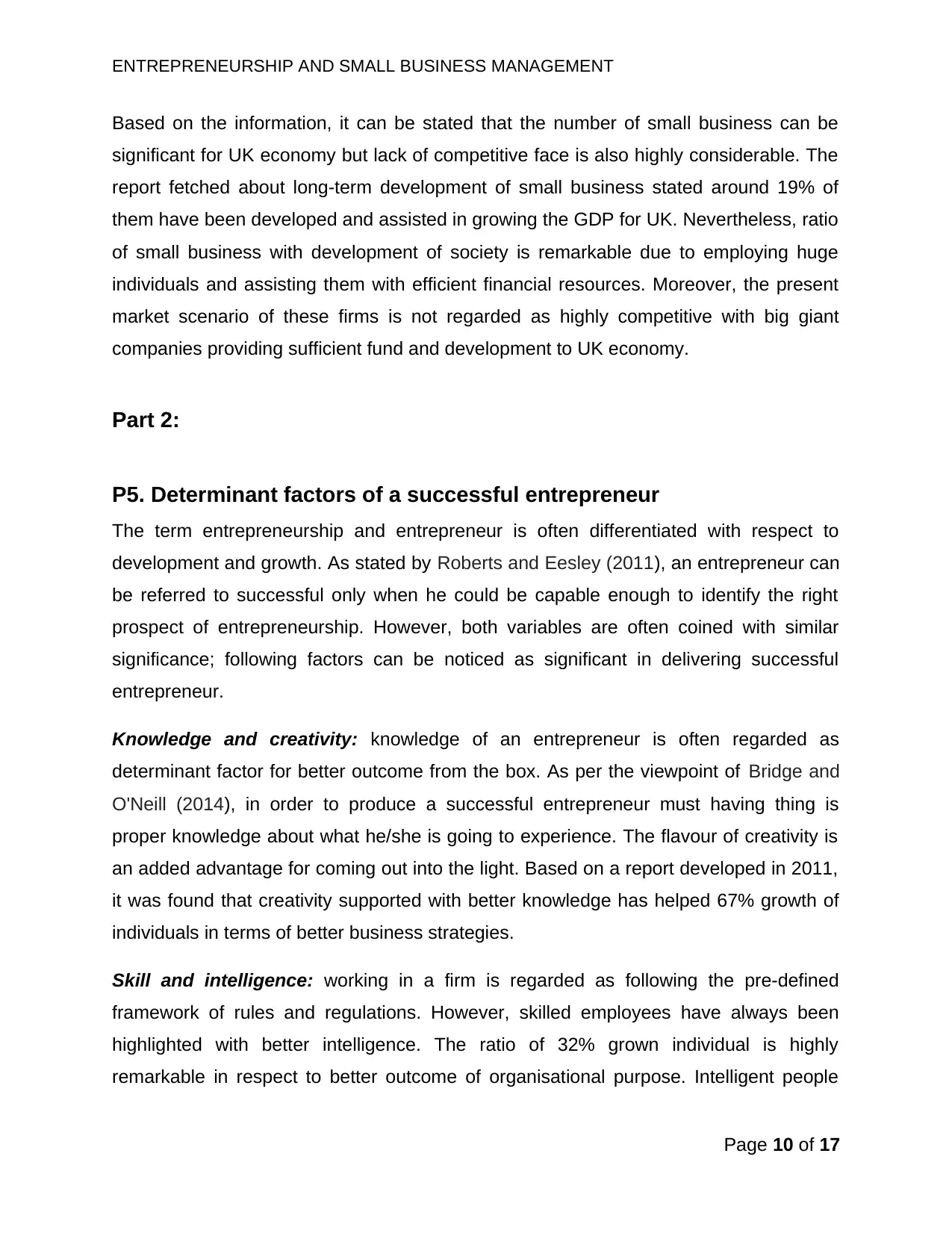
ENTREPRENEURSHIP AND SMALL BUSINESS MANAGEMENT
Based on the information, it can be stated that the number of small business can be
significant for UK economy but lack of competitive face is also highly considerable. The
report fetched about long-term development of small business stated around 19% of
them have been developed and assisted in growing the GDP for UK. Nevertheless, ratio
of small business with development of society is remarkable due to employing huge
individuals and assisting them with efficient financial resources. Moreover, the present
market scenario of these firms is not regarded as highly competitive with big giant
companies providing sufficient fund and development to UK economy.
Part 2:
P5. Determinant factors of a successful entrepreneur
The term entrepreneurship and entrepreneur is often differentiated with respect to
development and growth. As stated by Roberts and Eesley (2011), an entrepreneur can
be referred to successful only when he could be capable enough to identify the right
prospect of entrepreneurship. However, both variables are often coined with similar
significance; following factors can be noticed as significant in delivering successful
entrepreneur.
Knowledge and creativity: knowledge of an entrepreneur is often regarded as
determinant factor for better outcome from the box. As per the viewpoint of Bridge and
O'Neill (2014), in order to produce a successful entrepreneur must having thing is
proper knowledge about what he/she is going to experience. The flavour of creativity is
an added advantage for coming out into the light. Based on a report developed in 2011,
it was found that creativity supported with better knowledge has helped 67% growth of
individuals in terms of better business strategies.
Skill and intelligence: working in a firm is regarded as following the pre-defined
framework of rules and regulations. However, skilled employees have always been
highlighted with better intelligence. The ratio of 32% grown individual is highly
remarkable in respect to better outcome of organisational purpose. Intelligent people
Page 10 of 17
Based on the information, it can be stated that the number of small business can be
significant for UK economy but lack of competitive face is also highly considerable. The
report fetched about long-term development of small business stated around 19% of
them have been developed and assisted in growing the GDP for UK. Nevertheless, ratio
of small business with development of society is remarkable due to employing huge
individuals and assisting them with efficient financial resources. Moreover, the present
market scenario of these firms is not regarded as highly competitive with big giant
companies providing sufficient fund and development to UK economy.
Part 2:
P5. Determinant factors of a successful entrepreneur
The term entrepreneurship and entrepreneur is often differentiated with respect to
development and growth. As stated by Roberts and Eesley (2011), an entrepreneur can
be referred to successful only when he could be capable enough to identify the right
prospect of entrepreneurship. However, both variables are often coined with similar
significance; following factors can be noticed as significant in delivering successful
entrepreneur.
Knowledge and creativity: knowledge of an entrepreneur is often regarded as
determinant factor for better outcome from the box. As per the viewpoint of Bridge and
O'Neill (2014), in order to produce a successful entrepreneur must having thing is
proper knowledge about what he/she is going to experience. The flavour of creativity is
an added advantage for coming out into the light. Based on a report developed in 2011,
it was found that creativity supported with better knowledge has helped 67% growth of
individuals in terms of better business strategies.
Skill and intelligence: working in a firm is regarded as following the pre-defined
framework of rules and regulations. However, skilled employees have always been
highlighted with better intelligence. The ratio of 32% grown individual is highly
remarkable in respect to better outcome of organisational purpose. Intelligent people
Page 10 of 17
Secure Best Marks with AI Grader
Need help grading? Try our AI Grader for instant feedback on your assignments.
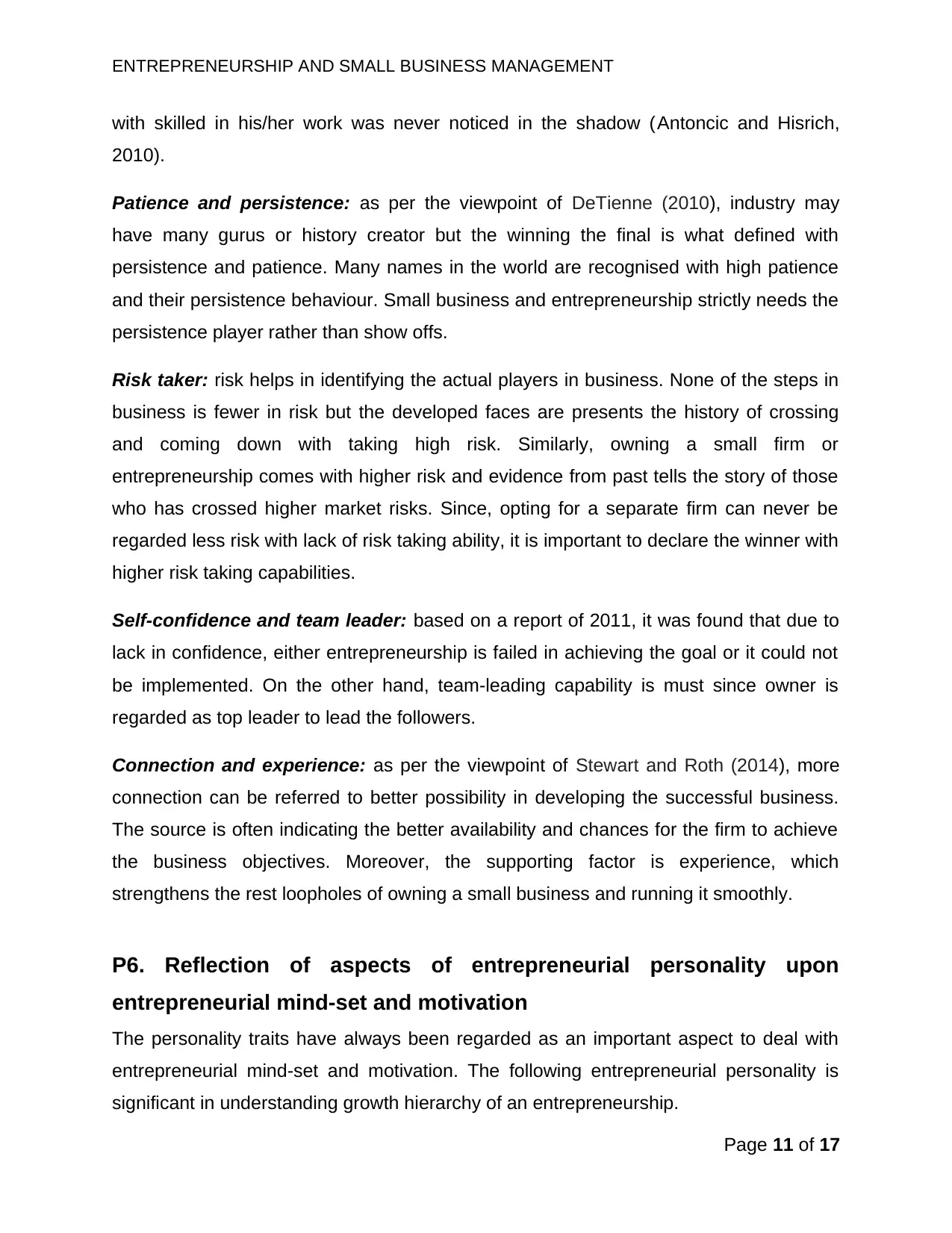
ENTREPRENEURSHIP AND SMALL BUSINESS MANAGEMENT
with skilled in his/her work was never noticed in the shadow (Antoncic and Hisrich,
2010).
Patience and persistence: as per the viewpoint of DeTienne (2010), industry may
have many gurus or history creator but the winning the final is what defined with
persistence and patience. Many names in the world are recognised with high patience
and their persistence behaviour. Small business and entrepreneurship strictly needs the
persistence player rather than show offs.
Risk taker: risk helps in identifying the actual players in business. None of the steps in
business is fewer in risk but the developed faces are presents the history of crossing
and coming down with taking high risk. Similarly, owning a small firm or
entrepreneurship comes with higher risk and evidence from past tells the story of those
who has crossed higher market risks. Since, opting for a separate firm can never be
regarded less risk with lack of risk taking ability, it is important to declare the winner with
higher risk taking capabilities.
Self-confidence and team leader: based on a report of 2011, it was found that due to
lack in confidence, either entrepreneurship is failed in achieving the goal or it could not
be implemented. On the other hand, team-leading capability is must since owner is
regarded as top leader to lead the followers.
Connection and experience: as per the viewpoint of Stewart and Roth (2014), more
connection can be referred to better possibility in developing the successful business.
The source is often indicating the better availability and chances for the firm to achieve
the business objectives. Moreover, the supporting factor is experience, which
strengthens the rest loopholes of owning a small business and running it smoothly.
P6. Reflection of aspects of entrepreneurial personality upon
entrepreneurial mind-set and motivation
The personality traits have always been regarded as an important aspect to deal with
entrepreneurial mind-set and motivation. The following entrepreneurial personality is
significant in understanding growth hierarchy of an entrepreneurship.
Page 11 of 17
with skilled in his/her work was never noticed in the shadow (Antoncic and Hisrich,
2010).
Patience and persistence: as per the viewpoint of DeTienne (2010), industry may
have many gurus or history creator but the winning the final is what defined with
persistence and patience. Many names in the world are recognised with high patience
and their persistence behaviour. Small business and entrepreneurship strictly needs the
persistence player rather than show offs.
Risk taker: risk helps in identifying the actual players in business. None of the steps in
business is fewer in risk but the developed faces are presents the history of crossing
and coming down with taking high risk. Similarly, owning a small firm or
entrepreneurship comes with higher risk and evidence from past tells the story of those
who has crossed higher market risks. Since, opting for a separate firm can never be
regarded less risk with lack of risk taking ability, it is important to declare the winner with
higher risk taking capabilities.
Self-confidence and team leader: based on a report of 2011, it was found that due to
lack in confidence, either entrepreneurship is failed in achieving the goal or it could not
be implemented. On the other hand, team-leading capability is must since owner is
regarded as top leader to lead the followers.
Connection and experience: as per the viewpoint of Stewart and Roth (2014), more
connection can be referred to better possibility in developing the successful business.
The source is often indicating the better availability and chances for the firm to achieve
the business objectives. Moreover, the supporting factor is experience, which
strengthens the rest loopholes of owning a small business and running it smoothly.
P6. Reflection of aspects of entrepreneurial personality upon
entrepreneurial mind-set and motivation
The personality traits have always been regarded as an important aspect to deal with
entrepreneurial mind-set and motivation. The following entrepreneurial personality is
significant in understanding growth hierarchy of an entrepreneurship.
Page 11 of 17
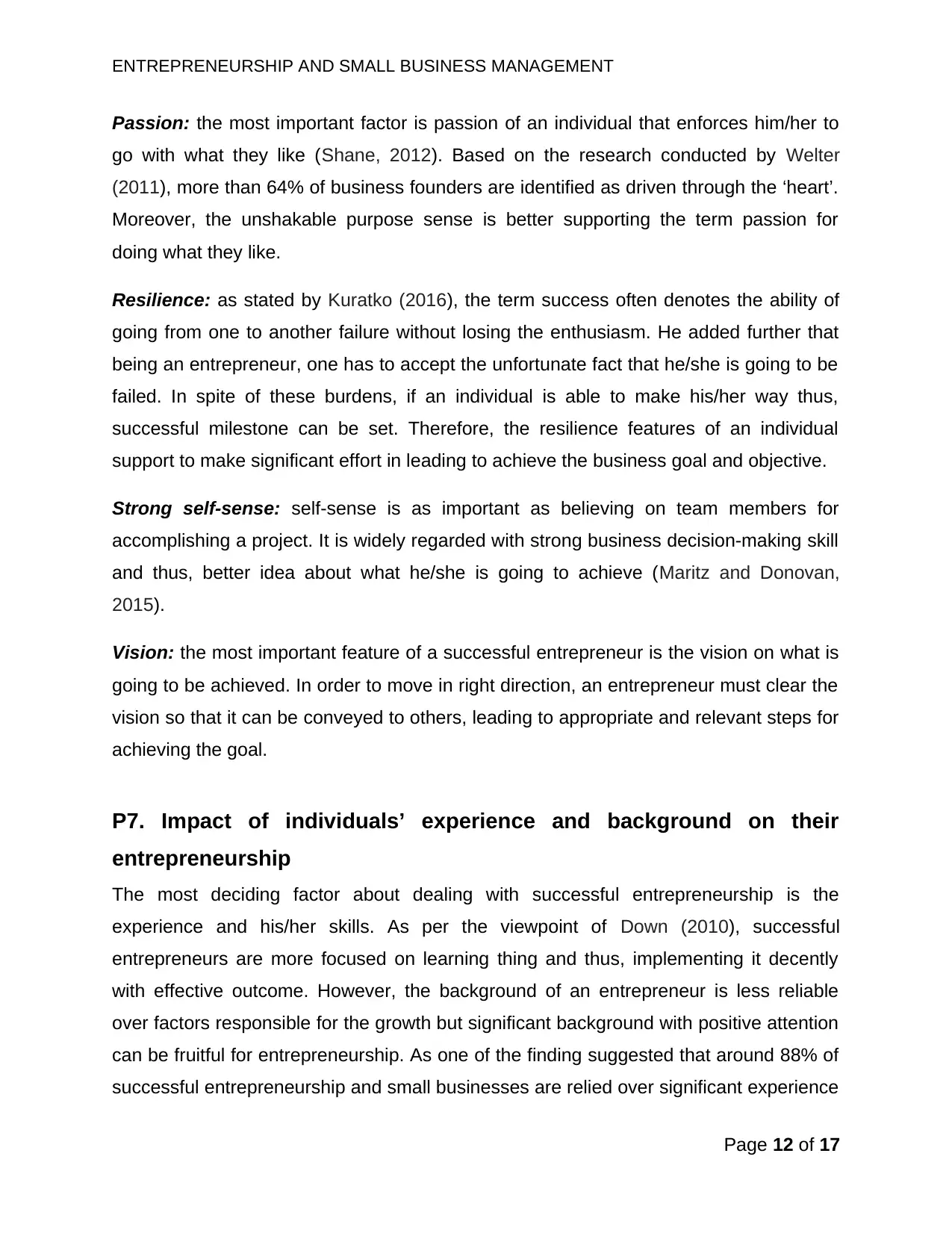
ENTREPRENEURSHIP AND SMALL BUSINESS MANAGEMENT
Passion: the most important factor is passion of an individual that enforces him/her to
go with what they like (Shane, 2012). Based on the research conducted by Welter
(2011), more than 64% of business founders are identified as driven through the ‘heart’.
Moreover, the unshakable purpose sense is better supporting the term passion for
doing what they like.
Resilience: as stated by Kuratko (2016), the term success often denotes the ability of
going from one to another failure without losing the enthusiasm. He added further that
being an entrepreneur, one has to accept the unfortunate fact that he/she is going to be
failed. In spite of these burdens, if an individual is able to make his/her way thus,
successful milestone can be set. Therefore, the resilience features of an individual
support to make significant effort in leading to achieve the business goal and objective.
Strong self-sense: self-sense is as important as believing on team members for
accomplishing a project. It is widely regarded with strong business decision-making skill
and thus, better idea about what he/she is going to achieve (Maritz and Donovan,
2015).
Vision: the most important feature of a successful entrepreneur is the vision on what is
going to be achieved. In order to move in right direction, an entrepreneur must clear the
vision so that it can be conveyed to others, leading to appropriate and relevant steps for
achieving the goal.
P7. Impact of individuals’ experience and background on their
entrepreneurship
The most deciding factor about dealing with successful entrepreneurship is the
experience and his/her skills. As per the viewpoint of Down (2010), successful
entrepreneurs are more focused on learning thing and thus, implementing it decently
with effective outcome. However, the background of an entrepreneur is less reliable
over factors responsible for the growth but significant background with positive attention
can be fruitful for entrepreneurship. As one of the finding suggested that around 88% of
successful entrepreneurship and small businesses are relied over significant experience
Page 12 of 17
Passion: the most important factor is passion of an individual that enforces him/her to
go with what they like (Shane, 2012). Based on the research conducted by Welter
(2011), more than 64% of business founders are identified as driven through the ‘heart’.
Moreover, the unshakable purpose sense is better supporting the term passion for
doing what they like.
Resilience: as stated by Kuratko (2016), the term success often denotes the ability of
going from one to another failure without losing the enthusiasm. He added further that
being an entrepreneur, one has to accept the unfortunate fact that he/she is going to be
failed. In spite of these burdens, if an individual is able to make his/her way thus,
successful milestone can be set. Therefore, the resilience features of an individual
support to make significant effort in leading to achieve the business goal and objective.
Strong self-sense: self-sense is as important as believing on team members for
accomplishing a project. It is widely regarded with strong business decision-making skill
and thus, better idea about what he/she is going to achieve (Maritz and Donovan,
2015).
Vision: the most important feature of a successful entrepreneur is the vision on what is
going to be achieved. In order to move in right direction, an entrepreneur must clear the
vision so that it can be conveyed to others, leading to appropriate and relevant steps for
achieving the goal.
P7. Impact of individuals’ experience and background on their
entrepreneurship
The most deciding factor about dealing with successful entrepreneurship is the
experience and his/her skills. As per the viewpoint of Down (2010), successful
entrepreneurs are more focused on learning thing and thus, implementing it decently
with effective outcome. However, the background of an entrepreneur is less reliable
over factors responsible for the growth but significant background with positive attention
can be fruitful for entrepreneurship. As one of the finding suggested that around 88% of
successful entrepreneurship and small businesses are relied over significant experience
Page 12 of 17
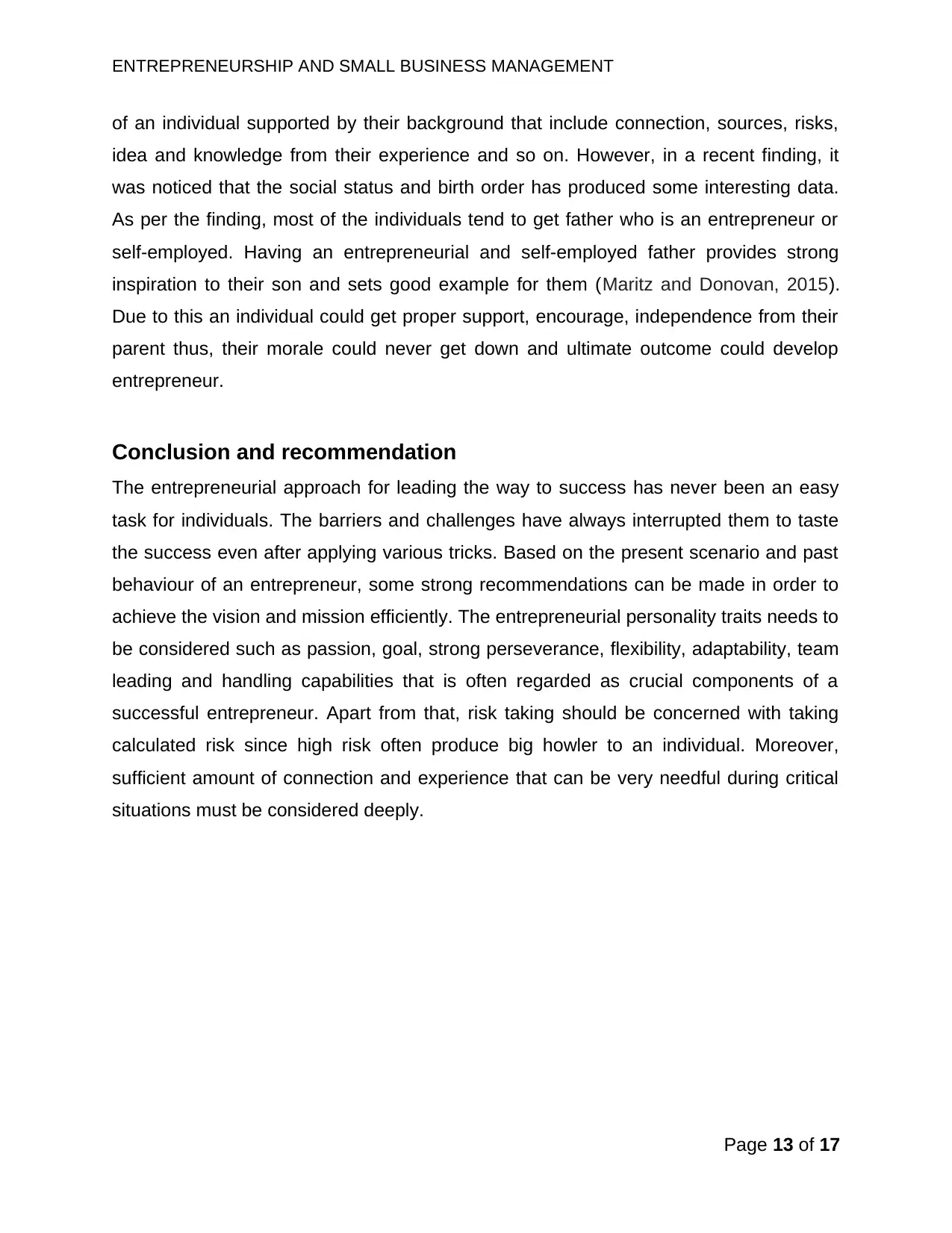
ENTREPRENEURSHIP AND SMALL BUSINESS MANAGEMENT
of an individual supported by their background that include connection, sources, risks,
idea and knowledge from their experience and so on. However, in a recent finding, it
was noticed that the social status and birth order has produced some interesting data.
As per the finding, most of the individuals tend to get father who is an entrepreneur or
self-employed. Having an entrepreneurial and self-employed father provides strong
inspiration to their son and sets good example for them (Maritz and Donovan, 2015).
Due to this an individual could get proper support, encourage, independence from their
parent thus, their morale could never get down and ultimate outcome could develop
entrepreneur.
Conclusion and recommendation
The entrepreneurial approach for leading the way to success has never been an easy
task for individuals. The barriers and challenges have always interrupted them to taste
the success even after applying various tricks. Based on the present scenario and past
behaviour of an entrepreneur, some strong recommendations can be made in order to
achieve the vision and mission efficiently. The entrepreneurial personality traits needs to
be considered such as passion, goal, strong perseverance, flexibility, adaptability, team
leading and handling capabilities that is often regarded as crucial components of a
successful entrepreneur. Apart from that, risk taking should be concerned with taking
calculated risk since high risk often produce big howler to an individual. Moreover,
sufficient amount of connection and experience that can be very needful during critical
situations must be considered deeply.
Page 13 of 17
of an individual supported by their background that include connection, sources, risks,
idea and knowledge from their experience and so on. However, in a recent finding, it
was noticed that the social status and birth order has produced some interesting data.
As per the finding, most of the individuals tend to get father who is an entrepreneur or
self-employed. Having an entrepreneurial and self-employed father provides strong
inspiration to their son and sets good example for them (Maritz and Donovan, 2015).
Due to this an individual could get proper support, encourage, independence from their
parent thus, their morale could never get down and ultimate outcome could develop
entrepreneur.
Conclusion and recommendation
The entrepreneurial approach for leading the way to success has never been an easy
task for individuals. The barriers and challenges have always interrupted them to taste
the success even after applying various tricks. Based on the present scenario and past
behaviour of an entrepreneur, some strong recommendations can be made in order to
achieve the vision and mission efficiently. The entrepreneurial personality traits needs to
be considered such as passion, goal, strong perseverance, flexibility, adaptability, team
leading and handling capabilities that is often regarded as crucial components of a
successful entrepreneur. Apart from that, risk taking should be concerned with taking
calculated risk since high risk often produce big howler to an individual. Moreover,
sufficient amount of connection and experience that can be very needful during critical
situations must be considered deeply.
Page 13 of 17
Paraphrase This Document
Need a fresh take? Get an instant paraphrase of this document with our AI Paraphraser
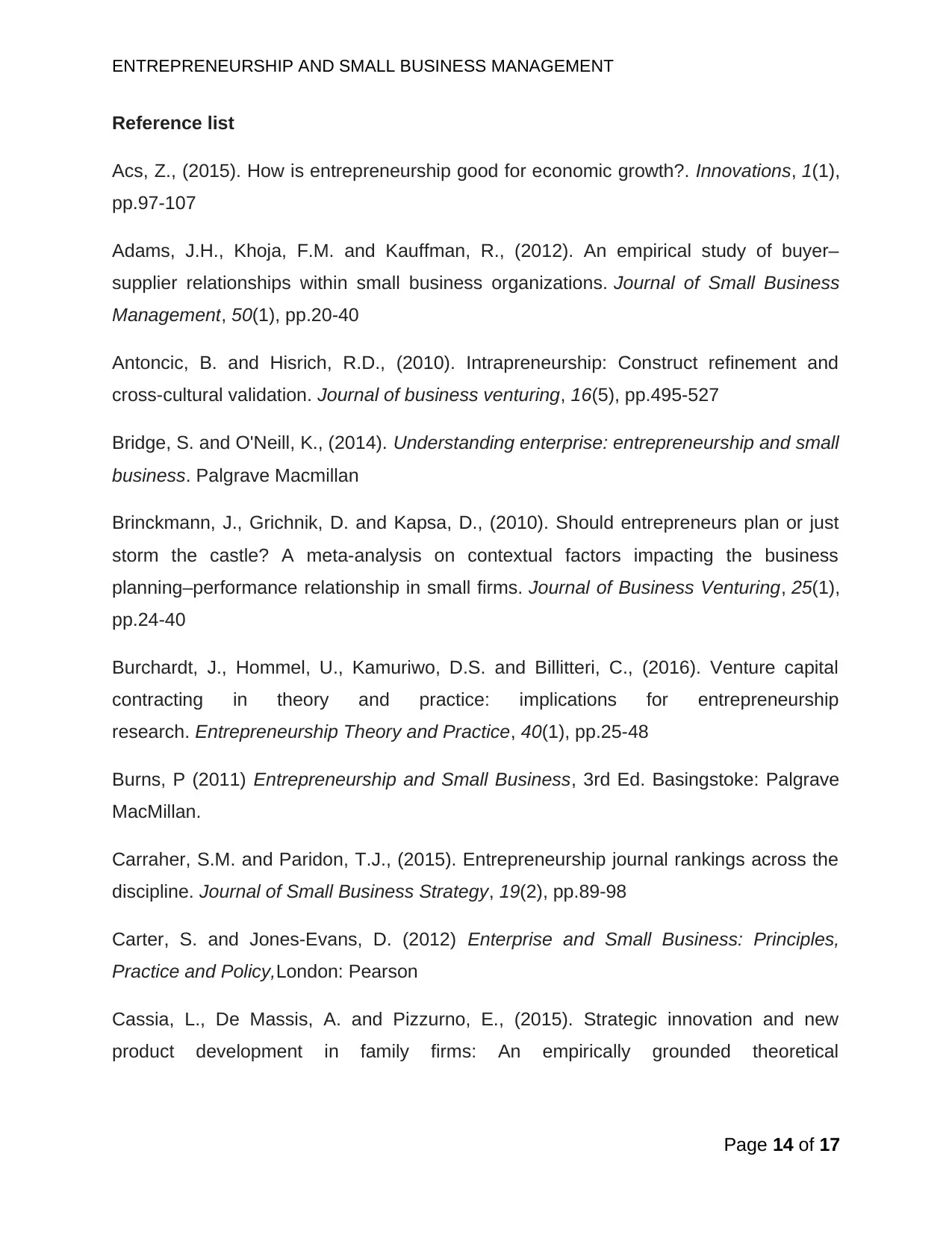
ENTREPRENEURSHIP AND SMALL BUSINESS MANAGEMENT
Reference list
Acs, Z., (2015). How is entrepreneurship good for economic growth?. Innovations, 1(1),
pp.97-107
Adams, J.H., Khoja, F.M. and Kauffman, R., (2012). An empirical study of buyer–
supplier relationships within small business organizations. Journal of Small Business
Management, 50(1), pp.20-40
Antoncic, B. and Hisrich, R.D., (2010). Intrapreneurship: Construct refinement and
cross-cultural validation. Journal of business venturing, 16(5), pp.495-527
Bridge, S. and O'Neill, K., (2014). Understanding enterprise: entrepreneurship and small
business. Palgrave Macmillan
Brinckmann, J., Grichnik, D. and Kapsa, D., (2010). Should entrepreneurs plan or just
storm the castle? A meta-analysis on contextual factors impacting the business
planning–performance relationship in small firms. Journal of Business Venturing, 25(1),
pp.24-40
Burchardt, J., Hommel, U., Kamuriwo, D.S. and Billitteri, C., (2016). Venture capital
contracting in theory and practice: implications for entrepreneurship
research. Entrepreneurship Theory and Practice, 40(1), pp.25-48
Burns, P (2011) Entrepreneurship and Small Business, 3rd Ed. Basingstoke: Palgrave
MacMillan.
Carraher, S.M. and Paridon, T.J., (2015). Entrepreneurship journal rankings across the
discipline. Journal of Small Business Strategy, 19(2), pp.89-98
Carter, S. and Jones-Evans, D. (2012) Enterprise and Small Business: Principles,
Practice and Policy,London: Pearson
Cassia, L., De Massis, A. and Pizzurno, E., (2015). Strategic innovation and new
product development in family firms: An empirically grounded theoretical
Page 14 of 17
Reference list
Acs, Z., (2015). How is entrepreneurship good for economic growth?. Innovations, 1(1),
pp.97-107
Adams, J.H., Khoja, F.M. and Kauffman, R., (2012). An empirical study of buyer–
supplier relationships within small business organizations. Journal of Small Business
Management, 50(1), pp.20-40
Antoncic, B. and Hisrich, R.D., (2010). Intrapreneurship: Construct refinement and
cross-cultural validation. Journal of business venturing, 16(5), pp.495-527
Bridge, S. and O'Neill, K., (2014). Understanding enterprise: entrepreneurship and small
business. Palgrave Macmillan
Brinckmann, J., Grichnik, D. and Kapsa, D., (2010). Should entrepreneurs plan or just
storm the castle? A meta-analysis on contextual factors impacting the business
planning–performance relationship in small firms. Journal of Business Venturing, 25(1),
pp.24-40
Burchardt, J., Hommel, U., Kamuriwo, D.S. and Billitteri, C., (2016). Venture capital
contracting in theory and practice: implications for entrepreneurship
research. Entrepreneurship Theory and Practice, 40(1), pp.25-48
Burns, P (2011) Entrepreneurship and Small Business, 3rd Ed. Basingstoke: Palgrave
MacMillan.
Carraher, S.M. and Paridon, T.J., (2015). Entrepreneurship journal rankings across the
discipline. Journal of Small Business Strategy, 19(2), pp.89-98
Carter, S. and Jones-Evans, D. (2012) Enterprise and Small Business: Principles,
Practice and Policy,London: Pearson
Cassia, L., De Massis, A. and Pizzurno, E., (2015). Strategic innovation and new
product development in family firms: An empirically grounded theoretical
Page 14 of 17
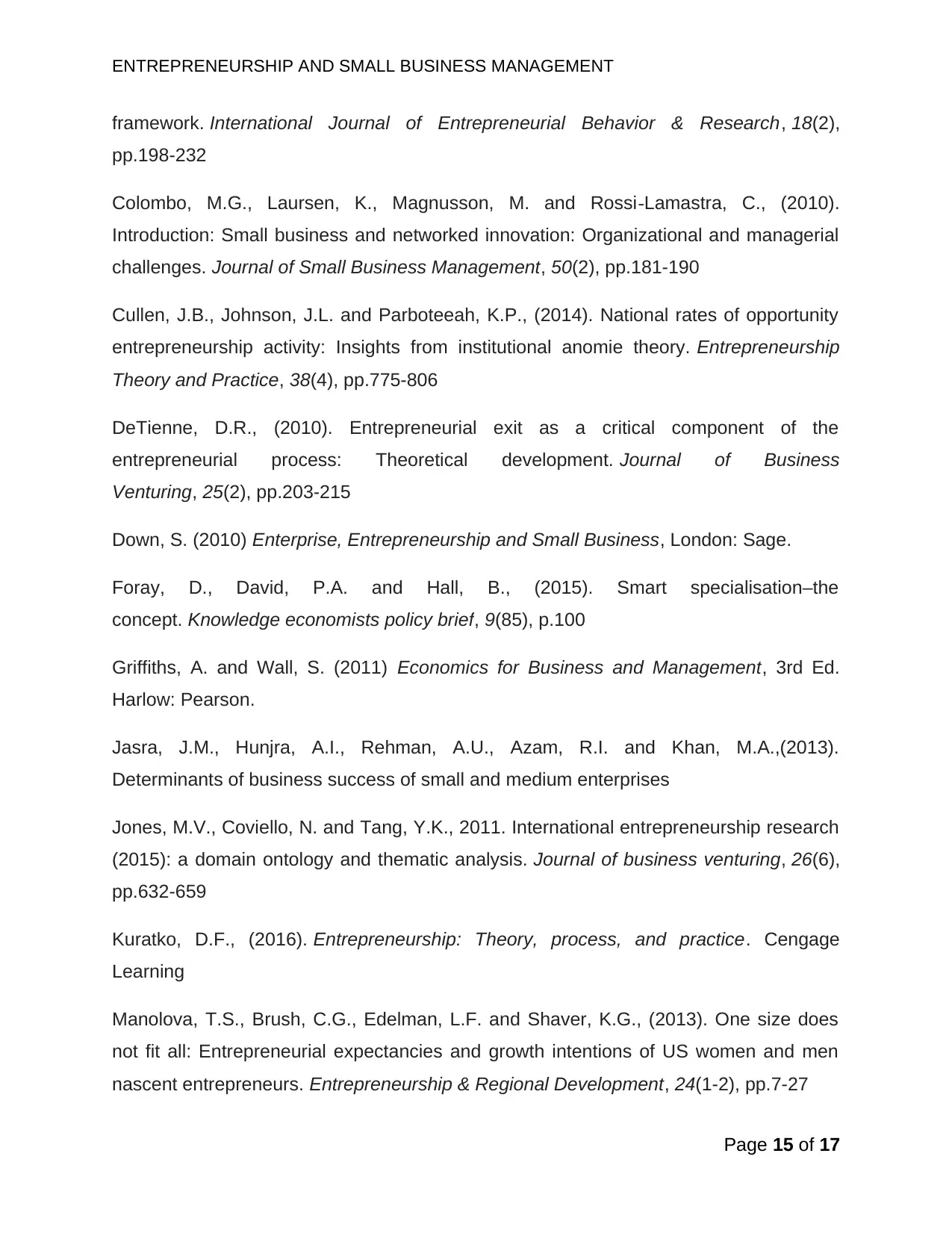
ENTREPRENEURSHIP AND SMALL BUSINESS MANAGEMENT
framework. International Journal of Entrepreneurial Behavior & Research, 18(2),
pp.198-232
Colombo, M.G., Laursen, K., Magnusson, M. and Rossi‐Lamastra, C., (2010).
Introduction: Small business and networked innovation: Organizational and managerial
challenges. Journal of Small Business Management, 50(2), pp.181-190
Cullen, J.B., Johnson, J.L. and Parboteeah, K.P., (2014). National rates of opportunity
entrepreneurship activity: Insights from institutional anomie theory. Entrepreneurship
Theory and Practice, 38(4), pp.775-806
DeTienne, D.R., (2010). Entrepreneurial exit as a critical component of the
entrepreneurial process: Theoretical development. Journal of Business
Venturing, 25(2), pp.203-215
Down, S. (2010) Enterprise, Entrepreneurship and Small Business, London: Sage.
Foray, D., David, P.A. and Hall, B., (2015). Smart specialisation–the
concept. Knowledge economists policy brief, 9(85), p.100
Griffiths, A. and Wall, S. (2011) Economics for Business and Management, 3rd Ed.
Harlow: Pearson.
Jasra, J.M., Hunjra, A.I., Rehman, A.U., Azam, R.I. and Khan, M.A.,(2013).
Determinants of business success of small and medium enterprises
Jones, M.V., Coviello, N. and Tang, Y.K., 2011. International entrepreneurship research
(2015): a domain ontology and thematic analysis. Journal of business venturing, 26(6),
pp.632-659
Kuratko, D.F., (2016). Entrepreneurship: Theory, process, and practice. Cengage
Learning
Manolova, T.S., Brush, C.G., Edelman, L.F. and Shaver, K.G., (2013). One size does
not fit all: Entrepreneurial expectancies and growth intentions of US women and men
nascent entrepreneurs. Entrepreneurship & Regional Development, 24(1-2), pp.7-27
Page 15 of 17
framework. International Journal of Entrepreneurial Behavior & Research, 18(2),
pp.198-232
Colombo, M.G., Laursen, K., Magnusson, M. and Rossi‐Lamastra, C., (2010).
Introduction: Small business and networked innovation: Organizational and managerial
challenges. Journal of Small Business Management, 50(2), pp.181-190
Cullen, J.B., Johnson, J.L. and Parboteeah, K.P., (2014). National rates of opportunity
entrepreneurship activity: Insights from institutional anomie theory. Entrepreneurship
Theory and Practice, 38(4), pp.775-806
DeTienne, D.R., (2010). Entrepreneurial exit as a critical component of the
entrepreneurial process: Theoretical development. Journal of Business
Venturing, 25(2), pp.203-215
Down, S. (2010) Enterprise, Entrepreneurship and Small Business, London: Sage.
Foray, D., David, P.A. and Hall, B., (2015). Smart specialisation–the
concept. Knowledge economists policy brief, 9(85), p.100
Griffiths, A. and Wall, S. (2011) Economics for Business and Management, 3rd Ed.
Harlow: Pearson.
Jasra, J.M., Hunjra, A.I., Rehman, A.U., Azam, R.I. and Khan, M.A.,(2013).
Determinants of business success of small and medium enterprises
Jones, M.V., Coviello, N. and Tang, Y.K., 2011. International entrepreneurship research
(2015): a domain ontology and thematic analysis. Journal of business venturing, 26(6),
pp.632-659
Kuratko, D.F., (2016). Entrepreneurship: Theory, process, and practice. Cengage
Learning
Manolova, T.S., Brush, C.G., Edelman, L.F. and Shaver, K.G., (2013). One size does
not fit all: Entrepreneurial expectancies and growth intentions of US women and men
nascent entrepreneurs. Entrepreneurship & Regional Development, 24(1-2), pp.7-27
Page 15 of 17
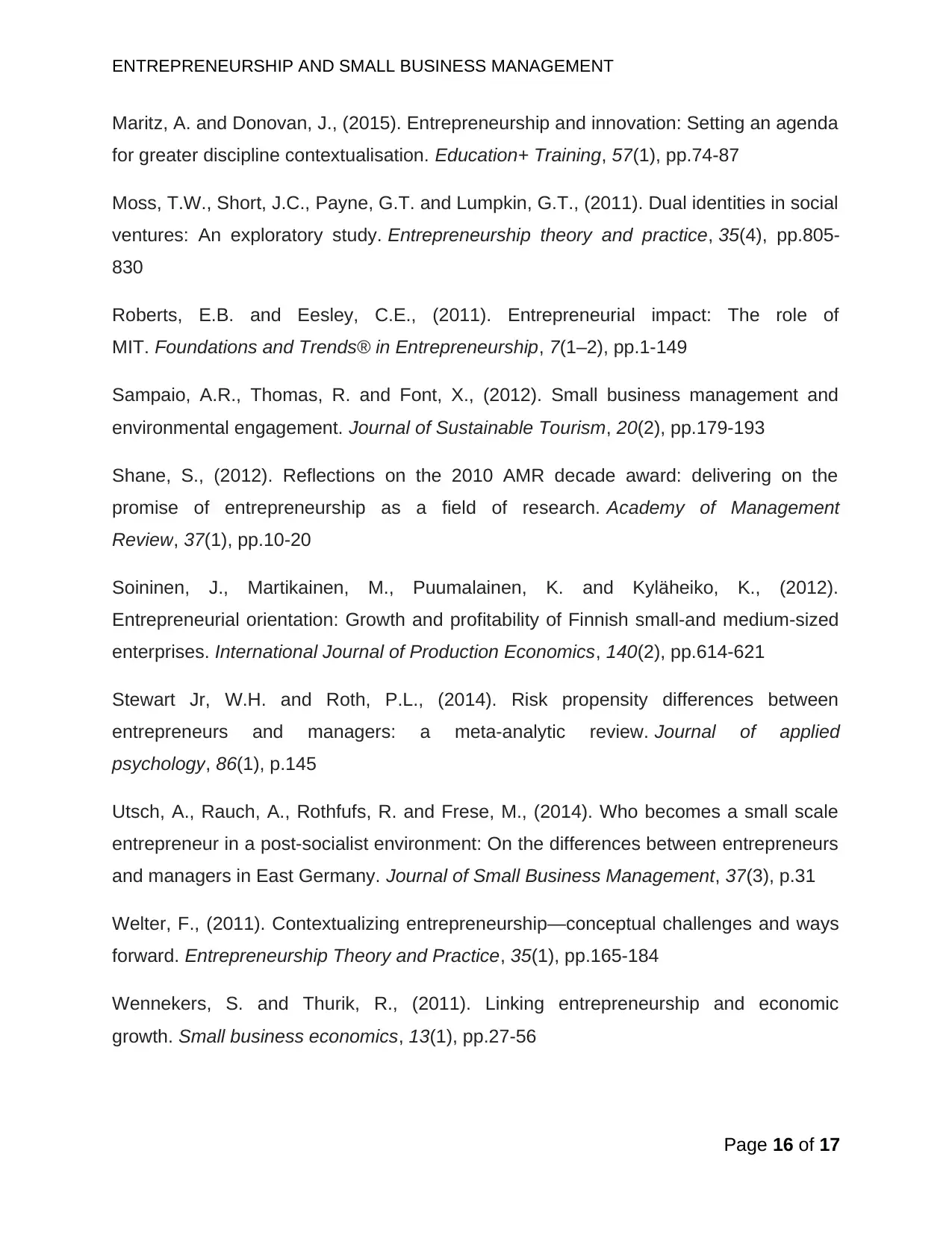
ENTREPRENEURSHIP AND SMALL BUSINESS MANAGEMENT
Maritz, A. and Donovan, J., (2015). Entrepreneurship and innovation: Setting an agenda
for greater discipline contextualisation. Education+ Training, 57(1), pp.74-87
Moss, T.W., Short, J.C., Payne, G.T. and Lumpkin, G.T., (2011). Dual identities in social
ventures: An exploratory study. Entrepreneurship theory and practice, 35(4), pp.805-
830
Roberts, E.B. and Eesley, C.E., (2011). Entrepreneurial impact: The role of
MIT. Foundations and Trends® in Entrepreneurship, 7(1–2), pp.1-149
Sampaio, A.R., Thomas, R. and Font, X., (2012). Small business management and
environmental engagement. Journal of Sustainable Tourism, 20(2), pp.179-193
Shane, S., (2012). Reflections on the 2010 AMR decade award: delivering on the
promise of entrepreneurship as a field of research. Academy of Management
Review, 37(1), pp.10-20
Soininen, J., Martikainen, M., Puumalainen, K. and Kyläheiko, K., (2012).
Entrepreneurial orientation: Growth and profitability of Finnish small-and medium-sized
enterprises. International Journal of Production Economics, 140(2), pp.614-621
Stewart Jr, W.H. and Roth, P.L., (2014). Risk propensity differences between
entrepreneurs and managers: a meta-analytic review. Journal of applied
psychology, 86(1), p.145
Utsch, A., Rauch, A., Rothfufs, R. and Frese, M., (2014). Who becomes a small scale
entrepreneur in a post-socialist environment: On the differences between entrepreneurs
and managers in East Germany. Journal of Small Business Management, 37(3), p.31
Welter, F., (2011). Contextualizing entrepreneurship—conceptual challenges and ways
forward. Entrepreneurship Theory and Practice, 35(1), pp.165-184
Wennekers, S. and Thurik, R., (2011). Linking entrepreneurship and economic
growth. Small business economics, 13(1), pp.27-56
Page 16 of 17
Maritz, A. and Donovan, J., (2015). Entrepreneurship and innovation: Setting an agenda
for greater discipline contextualisation. Education+ Training, 57(1), pp.74-87
Moss, T.W., Short, J.C., Payne, G.T. and Lumpkin, G.T., (2011). Dual identities in social
ventures: An exploratory study. Entrepreneurship theory and practice, 35(4), pp.805-
830
Roberts, E.B. and Eesley, C.E., (2011). Entrepreneurial impact: The role of
MIT. Foundations and Trends® in Entrepreneurship, 7(1–2), pp.1-149
Sampaio, A.R., Thomas, R. and Font, X., (2012). Small business management and
environmental engagement. Journal of Sustainable Tourism, 20(2), pp.179-193
Shane, S., (2012). Reflections on the 2010 AMR decade award: delivering on the
promise of entrepreneurship as a field of research. Academy of Management
Review, 37(1), pp.10-20
Soininen, J., Martikainen, M., Puumalainen, K. and Kyläheiko, K., (2012).
Entrepreneurial orientation: Growth and profitability of Finnish small-and medium-sized
enterprises. International Journal of Production Economics, 140(2), pp.614-621
Stewart Jr, W.H. and Roth, P.L., (2014). Risk propensity differences between
entrepreneurs and managers: a meta-analytic review. Journal of applied
psychology, 86(1), p.145
Utsch, A., Rauch, A., Rothfufs, R. and Frese, M., (2014). Who becomes a small scale
entrepreneur in a post-socialist environment: On the differences between entrepreneurs
and managers in East Germany. Journal of Small Business Management, 37(3), p.31
Welter, F., (2011). Contextualizing entrepreneurship—conceptual challenges and ways
forward. Entrepreneurship Theory and Practice, 35(1), pp.165-184
Wennekers, S. and Thurik, R., (2011). Linking entrepreneurship and economic
growth. Small business economics, 13(1), pp.27-56
Page 16 of 17
Secure Best Marks with AI Grader
Need help grading? Try our AI Grader for instant feedback on your assignments.

ENTREPRENEURSHIP AND SMALL BUSINESS MANAGEMENT
Wood, M., Welter, C., Artz, K. and Bradley, S.W., (2014). Discerning opportunity types:
implications for entrepreneurial action and entrepreneurship education. In Innovative
Pathways for University Entrepreneurship in the 21st Century, pp. 119-144
Page 17 of 17
Wood, M., Welter, C., Artz, K. and Bradley, S.W., (2014). Discerning opportunity types:
implications for entrepreneurial action and entrepreneurship education. In Innovative
Pathways for University Entrepreneurship in the 21st Century, pp. 119-144
Page 17 of 17
1 out of 17
Your All-in-One AI-Powered Toolkit for Academic Success.
+13062052269
info@desklib.com
Available 24*7 on WhatsApp / Email
![[object Object]](/_next/static/media/star-bottom.7253800d.svg)
Unlock your academic potential
© 2024 | Zucol Services PVT LTD | All rights reserved.




